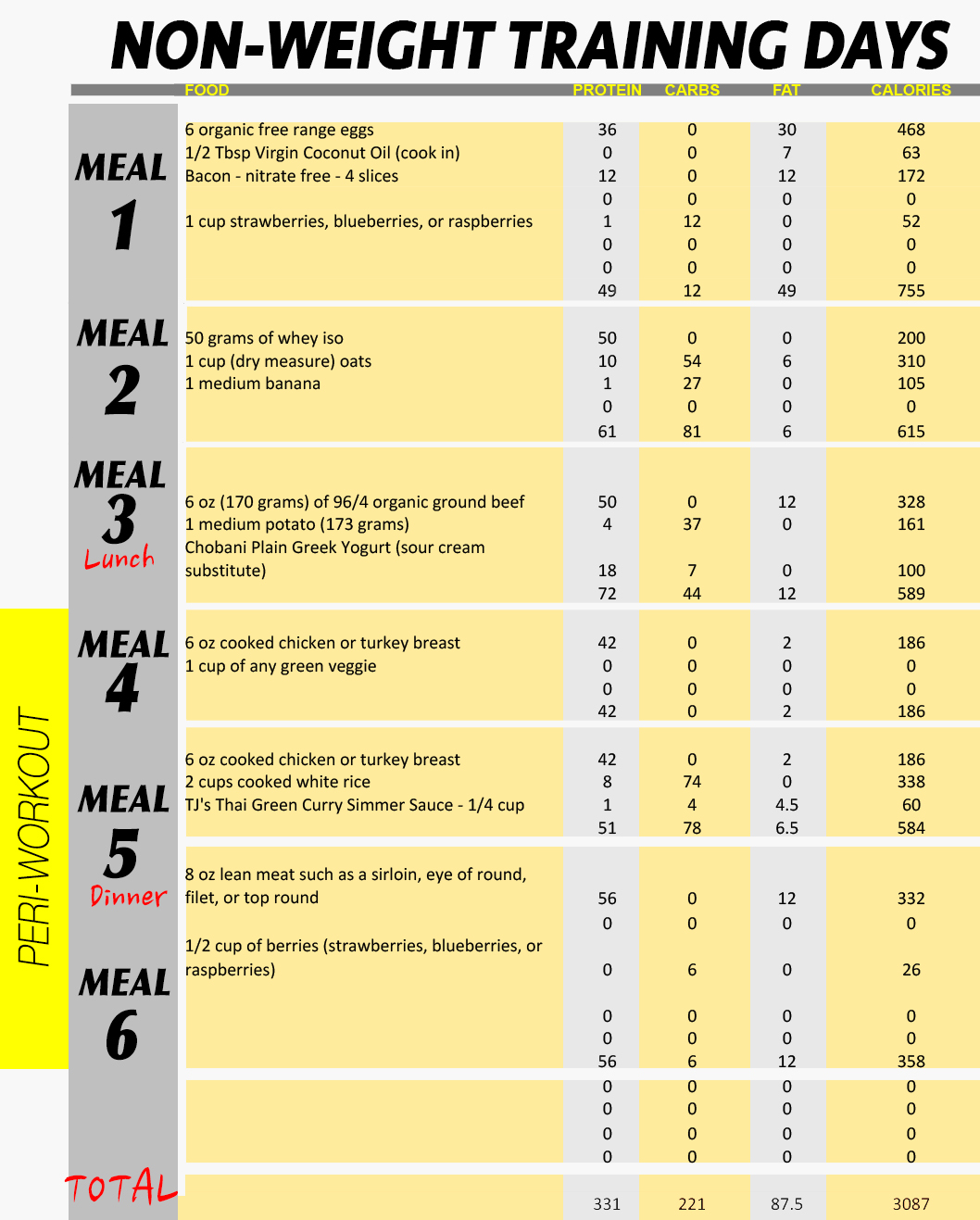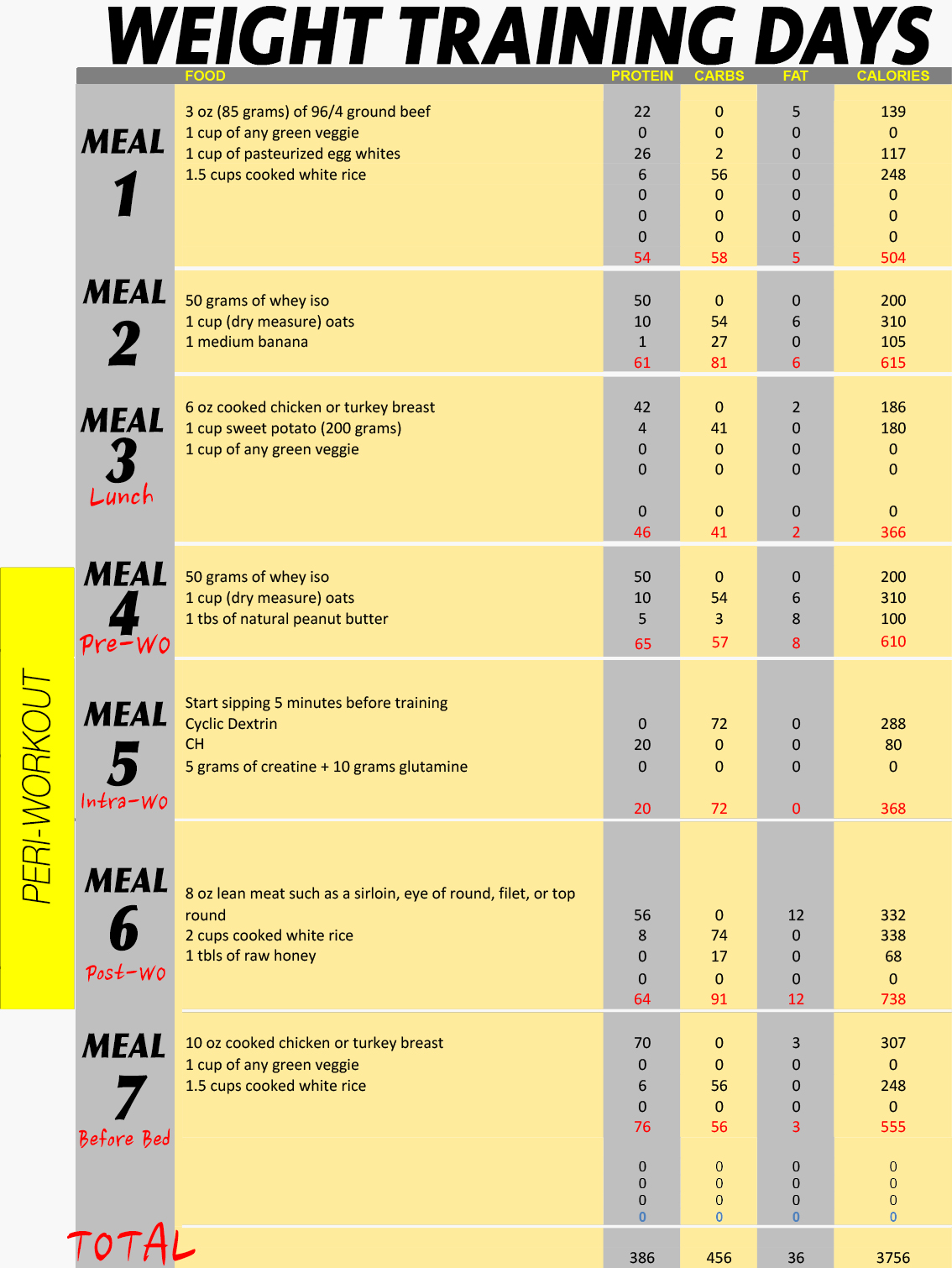
“Now it is time to push hard,” Meadows said, as I looked at my new diet update and realized carbs were being reduced — again. Up until this point I have felt very good. I’ve felt strong, energized, and have not experienced many of the negative drawbacks often associated with dieting. However, this diet change was noticeably affecting me in more ways than one. My energy is low, strength and endurance have been negatively affected, and my hunger is through the roof. As a result this was not conducive to my normal 2+ hour training session, targeting 3-4 muscles groups. Therefore, I made the instinctual decision to start splitting my training into a.m. and p.m. sessions spacing them roughly 6-8 hours apart to maximize optimal results.
Over time and with much trail and error, I have found my two-a-day training split to be most effective at this point in my contest prep. The key to success when dieting for a bodybuilding show is muscle retention and keeping your metabolic rate elevated throughout the duration of your prep. The more muscle mass you have, the higher your metabolic rate. Therefore it is imperative to retain muscle mass when in a calorie deficit, to maintain an elevated metabolic rate. Resistance training two times a day seems to be the best strategy for muscle retention.
Each training session is roughly 60 minutes long, anything lasting more than 60 minutes is when I begin to feel myself fading in performance and focus. I keep my rest periods between 60-90 seconds for most lifts. I have found this to be optimal for myself from a recover and performance standpoint. If I shorten my rest periods any more, my performance output suffers tremendously. My training is still structured into a three day split. On the first day, I perform all pushing movements. The muscle groups I train in the a.m. session are chest, shoulders, triceps. The p.m. sessions are quads. The following day I will perform all pulling movements. The muscle groups in the a.m. session consist of the back and biceps, and p.m. sessions are hamstrings. The third day I train traps, calves, and abs in the a.m. session and glutes in the p.m. session.
The shorter sessions make it easier to focus on lifting quality, keeping my training intensity high, and getting the most out of every session. The ability to recover between training sessions helps me enter each workout with focus and maintain it, instead of fading out during my traditional two hour training sessions. This will also result in a greater deficit throughout the day due to an increase in EPOC (excess post-exercise oxygen consumption), causing more fat loss. Training with maximum intensity and short rest intervals can increase the activity in your mitochondria, which results in a greater oxidative capacity for fat loss.
This approach has been very effective over the last month and progressed my fat loss tremendously while still allowing me to maintain my strength, performance, and muscle mass. However, this is not a technique you can use for extended periods of time. Your body may become over trained and this will negatively effective your CNS, endocrine, and muscular system. I began to experience some of these negative symptoms recently. Trouble sleeping, prolonged soreness, weight crashes, and sickness are just a few of them. These were all clear signs it was time to scale back and allow my body to reset, rest and recover. I will now revert back to training one time a day with overall less volume until I feel I have recovered and my body is ready for that level of stress again, which will be just in time for my final push leading into Team Universe.
Here's a technical breakdown of what I'm doing:
With Meadows back in charge of my dietary protocol again since April of 2014. John had me performing prowler pushes for cardio four days a week, and weight training six days a week. This continued for the following six months while we gradually brought carbs and overall calories down until I reached a level of leanness that he was happy with. Once I had reached my new set point we began increasing carbohydrates every few weeks. I increased my level of insulin sensitivity by reducing my overall body fat, which resulted in an increased ability to utilize these extra carbohydrates and I was able to get leaner while increasing food intake and reducing cardio.
February of 2015 – Start Pre-Contest Diet
Cardio – Zero
Weight training – 6 days per week
Cheat meals – I had not had a cheat meal or re-feed since December 6. There was no need for this because I was continually increasing food intake.
Nutrition – The meal plan is split between training days and off days.
February 8th, 2015 – 21 Weeks Out
Nutritional Adjustments on Training Days:
Meal 1: Reduced from 1.5 cups of white rice to 1 cup of white rice.
Meal 2: Dropped 1 medium banana
Nutritional Adjustments on Non-Training Days:
Meal 2: Dropped 1 medium banana
Re-feeds: Two re-feeds a week consisting of 200 grams of carbohydrates in the two meals following training.
Cardio – Zero
Weight Training – 6 days per week
February 23th, 2015 – 18.5 Weeks Out
Nutritional Adjustments on Training Days:
Meal 2: Reduced from 1 cup dry measured oats to ½ cup dry measured oats.
Meal 4: Reduced from 1 cup dry measured oats to ½ cup dry measured oats.
Nutritional Adjustments on Non-Training Days:
Meal 2: Reduced from 1 cup dry measured oats to ½ cup dry measured oats.
Re-feeds: Two re-feeds a week consisting of 200 grams of carbohydrates in the two meals following training.
Cardio – Zero
Weight Training – 6 days per week
March 2nd, 2015 – 17.5 Weeks Out
Nutritional Adjustments on Training Days:
Meal 7: Dropped the 1.5 cups of white rice in last meal.
Nutritional Adjustments on Non-Training Days:
Re-feeds: Two re-feeds a week consisting of 200 grams of carbohydrates in the two meals following training.
Cardio – Zero
Weight Training – 6 days per week
March 30th, 2015 – 13.5 Weeks Out
Nutritional Adjustments on Training Days:
Meal 1: Dropped the 1 cup of white rice in first meal meal.
Meal 2: Exchanged 50 grams of whey isolate and ½ cup of dry measured oats for 8 oz of cod and 1 cup of broccoli.
Nutritional Adjustments on Non-Training Days:
Re-feeds: Two re-feeds a week consisting of 200 grams of carbohydrates in the two meals following training.
Cardio – Zero
Weight Training – 6 days per week
April 13th, 2015 – 11.5 Weeks Out
Nutritional Adjustments on Training Days:
Meal 3: Dropped 200 grams of sweet potato.
Nutritional Adjustments on Non-Training Days:
Re-feeds: Two re-feeds a week consisting of 200 grams of carbohydrates in the two meals following training.
Cardio – Zero
Weight Training – 6 days per week














1 Comment